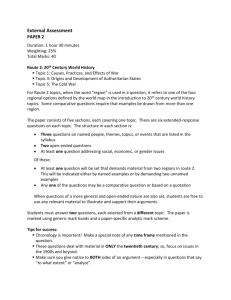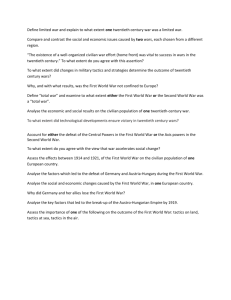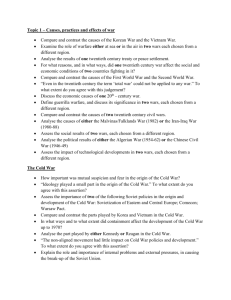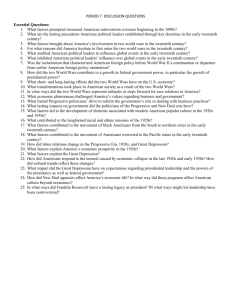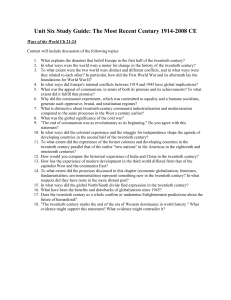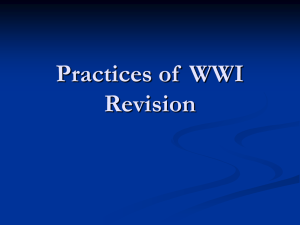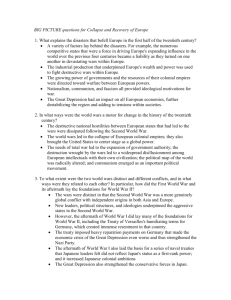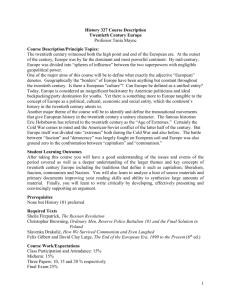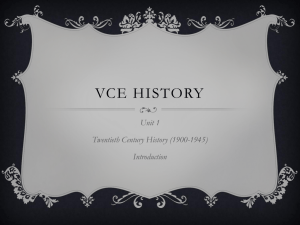Questions to select from for your 20th century project
advertisement
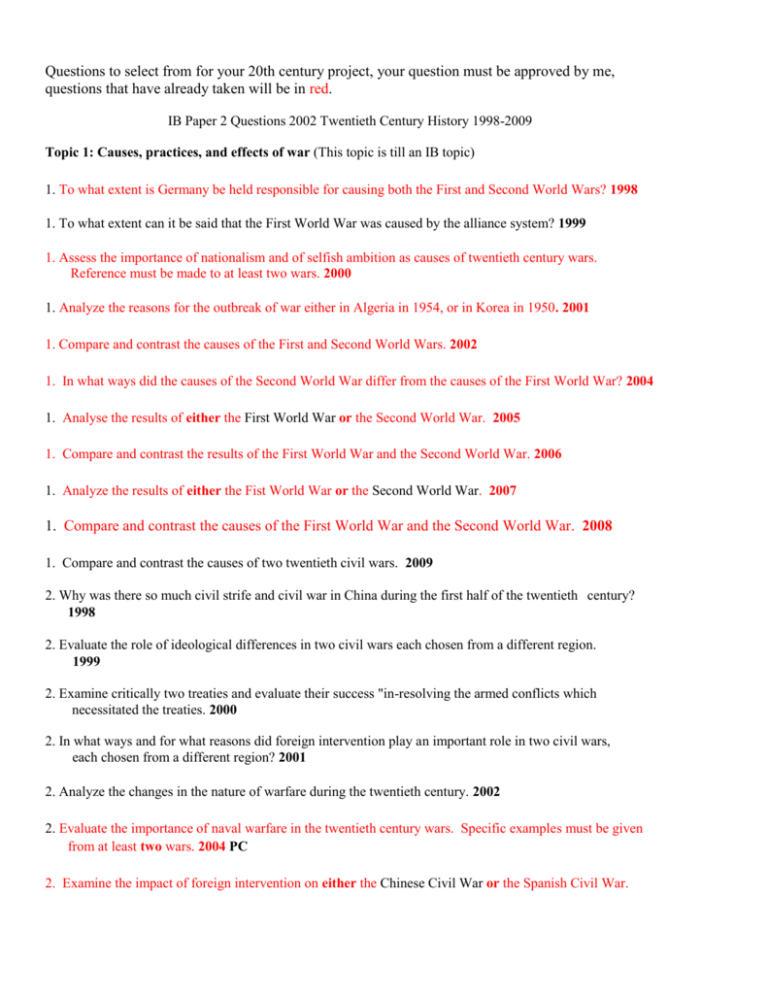
Questions to select from for your 20th century project, your question must be approved by me, questions that have already taken will be in red. IB Paper 2 Questions 2002 Twentieth Century History 1998-2009 Topic 1: Causes, practices, and effects of war (This topic is till an IB topic) 1. To what extent is Germany be held responsible for causing both the First and Second World Wars? 1998 1. To what extent can it be said that the First World War was caused by the alliance system? 1999 1. Assess the importance of nationalism and of selfish ambition as causes of twentieth century wars. Reference must be made to at least two wars. 2000 1. Analyze the reasons for the outbreak of war either in Algeria in 1954, or in Korea in 1950. 2001 1. Compare and contrast the causes of the First and Second World Wars. 2002 1. In what ways did the causes of the Second World War differ from the causes of the First World War? 2004 1. Analyse the results of either the First World War or the Second World War. 2005 1. Compare and contrast the results of the First World War and the Second World War. 2006 1. Analyze the results of either the Fist World War or the Second World War. 2007 1. Compare and contrast the causes of the First World War and the Second World War. 2008 1. Compare and contrast the causes of two twentieth civil wars. 2009 2. Why was there so much civil strife and civil war in China during the first half of the twentieth century? 1998 2. Evaluate the role of ideological differences in two civil wars each chosen from a different region. 1999 2. Examine critically two treaties and evaluate their success "in-resolving the armed conflicts which necessitated the treaties. 2000 2. In what ways and for what reasons did foreign intervention play an important role in two civil wars, each chosen from a different region? 2001 2. Analyze the changes in the nature of warfare during the twentieth century. 2002 2. Evaluate the importance of naval warfare in the twentieth century wars. Specific examples must be given from at least two wars. 2004 PC 2. Examine the impact of foreign intervention on either the Chinese Civil War or the Spanish Civil War. 2005 2. To what extent did technological developments ensure victory in twentieth century wars? 2006 2. Examine the impact of foreign intervention on either the Chinese Civil War or the Spanish Civil War. 2007 2. To what extent did changes in military tactics and strategies determine the outcome of twentieth century wars? 2008 2. Define guerilla warfare, and discuss its significance in two wars, each chosen from a different region. 2009 3. Compare and contrast the outcome and effects of two revolutionary wars, each chosen from a different region. 1998 3. In what ways and for what reasons have tactics changed in twentieth century warfare? 1999 3. Compare and contrast the effects for the country concerned of two of the following: the Chinese Civil War, the Nigerian Civil War, and the Spanish Civil War. 2000 3. Evaluate the successes and failures of one twentieth century treaty in addressing the causes of conflict, and restoring peace and normality. 2001 3. Why were there so many civil wars in the twentieth century? 2002 3. Why were there so many Arab-Israeli wars between 1948 and 1978? 2004 3. Assess the social and economic causes of one twentieth century war. 2005 3. “No twentieth century war could be called a limited war.” To what extent do you agree with this assertion? 2006 3. Assess the social and economic causes of one twentieth-century war. 2007 3. “Even in the twentieth century the term ‘total war’ could not be applied to any war.” To what extent do you agree with this judgment. 2008 3. Analyze (a) the short – term results, and (b) the long term results up to 1935, of the First World War. 2009 4. How and why has guerrilla warfare been used in the twentieth century? Examples should be given from at least two different regions. 1998 4. How valid is the claim that treaties are not necessary to end wars? Support your answer with evidence from at least two regions. 1999 4. Assess the significance of either the Mexican Revolution (1910 to 1940) or the Vietnam War (1964 to 1975). 2000 4. Assess the results of both the Arab-Israeli war of 1956 (Sinai Campaign) and the 1967 Six Day War. 2001 4. Examine the effects of war and the fear of war on the civilian population of two countries, each chosen horn a different region. 2002 4. Analyze the results of two wars, each chosen from a different region. 2004 4. Compare and contrast the use of naval warfare in two wars, each chosen from a different region. 2005 4. Analyze the causes of either the Spanish Civil War or the Korean War. 2006 4. Compare and contrast the use of naval warfare in two wars, each chosen from a different region. 2007 4. Analyze the results of either the Mexican Revolution or the Russian Civil War. 2008 C.M. 4. In what ways, and with what results, did either the Korean War or the Vietnam War bring about social and cultural changes in the countries involved. 2009 5. Explain the impact of war on two of the following: women, the arts; the media. 1998 5. Explain, with specific examples horn their work, how artists have reacted to two of the following: Mexican Revolution, Spanish Civil War; Vietnam War. 1999 5. In what ways have wars (a) caused suffering and hardship to women and (b) helped promote women's equality? Specific evidence must be given horn at least two regions. 2000 5. Using specific examples explain the popularity of war themes in (a) films and (b) novels and/or plays. 2001 5. "The Korean War was a limited war, a civil war, and an episode in the Cold War." To what extent do agree with each part of this assertion? 2002 you 5. Assess the social and economic effects of one war on two of the countries involved, in the ten years following the end of the war. 2004 5. For what reasons, and with what results, was “limited” warfare a feature of the second half of the twentieth century? 2005 5. Assess the social results of two wars, each chosen form a different region. 2006 5. For what reasons, and with what results, was “limited” warfare a feature of the second half of the twentieth century? 2007 5. In what ways and with what results did two wars, each chosen from a different region, affect the role and status of women? 2008 5. In what ways, and for what reasons, did the nature of war in the air change between 1939 and 1990? 2009 Topic 3: The rise and rule of single-party states (This topic has changed ever so slightly, but still significantly, it is now Origins and development of authoritarian and single – party states) 11. Account for the rise to power of either Juan Peron or Francisco Franco, and assess the impact upon either Argentina or Spain of your chosen ruler. 1998 11. "Single party states use education as propaganda to obtain support rather than to instill (increase) knowledge." How far do you agree with this judgment? 1999 11. In what ways, and for what reasons, did rulers of single.-party states play an important role in world affairs between 1917 and 19457 2000 11. "Promises of improved social and economic conditions win more support for would-be single-party rulers than ideological pronouncements." How far do you agree with this claim? 2001 11. Analyze conditions that led to single-party states during the twentieth century. 2002 11. Analyze the methods used by one single–party state in his successful bid for power. 2004 11. Analyse the methods used and the condition which helped in the rise to power of one ruler of a singleparty state. 2005 Joe 11. To what extent was the rise to power of either Hitler or Moa due to personal appeal and ability? 2006dd 11. Analyse the methods used and the condition which helped in the rise to power of one ruler of a singleparty state. 2007 11. Compare and contrast the rise to power of two rulers of single-party states, each chosen from a different region. 2008 EI 11. Analyze the methods used by either Castro or Peron to obtain power. 2009 12. To what extent is it true that a successful economic policy is the most important factor for a single party to remain in power? Examples should be given from two countries each chosen from different regions. 1998 12. In what ways and for what reasons did China develop its own brand of Marxism/Communism under Mao Zedong? 1999 12. Identify the main principles of Communism and assess how far these principles were put into practice by one Communist ruler between 1900 and 1990. 2000 12. Compare and contrast the organization of one Communist state with one Fascist state. 12. Compare and contrast the domestic policies of Hitler and Stalin. 2001 2002 PC 12. Evaluate the importance of ideology in the policies of two of the following rulers of single-party states: Castro; Hitler; Lenin; Nyrere. 2004 12. Evaluate the successes and failures of one ruler of a single-party state. 2005 HE 12. Compare and contrast the domestic policies of two rulers of single-party states, each chosen form a different region. 2006 12. Evaluate the successes and failures of one ruler of a single-party state. 2007 12. To what extent was either Mussolini, between 1922 and 1945, or Nasser, between 1954 and 1970, successful in achieving his aims? 2008 12. “The aims and policies of single – party states rulers rarely followed their declared ideology.” To what extent do you agree with this assertion? 2009 13. Compare and contrast the foreign policies of two rulers of single party states, each chosen from a different region. 1998 13. To what extent was Spain under Franco (1939 to 1975) a Fascist state? 1999 13. Account for the rise to power and longevity of the rule of either Fidel Castro in Cuba or Julius Nyerere in Tanzania. 2000 13. Analyze the methods by which either Castro or Stalin maintained, his position as ruler of a singleparty state. 2001 13. In what ways, and for what reasons, did two rulers of single-party states, each chosen from a different region, fail to achieve their objective? 2002 13. Compare and contrast the foreign policies of two rulers of single-party states, each chosen from a different region. 2004 13. Assess the methods used by either Nasser or Peron to remain in power. 2005 13. Assess the methods used by either Nasser or Peron to remain in power. 2006 13. Assess the methods used by either Lenin or Peron to maintain his regime. 2007 13. In what ways did one ruler of a single-party state try to use education to support his regime? 2008 13. Evaluate the domestic policies of either Hitler or Nasser. 2009 14. To what extent was Hitler a) responsible for, and b) driven by the ideological beliefs of Nazism? 1998 14. How far is it true to say that a successful foreign policy is the most important factor for a single party ruler to remain in power? Examples should be given from two countries each chosen from a different region. 1999 14. Assess the contributions or organizational and leadership qualities in maintaining in power two single-party rulers, each chosen from a different region. 2000 14. Assess the successes and failures of two of the following: Nasser's rule of Egypt; Nyerere's rule of Tanzania; Tito's rule of Yugoslavia. 2001 14. Explain and examine the methods used by one of the following rulers of single-party states, to obtain and keep power: Lenin; Mao; Peron. 2002 14. In what ways, and to what extent, did either Nasser or Peron improve social and economic conditions. 2004 14. Compare and contrast the influence outside their own countries of Hitler and Mao. 2005 14. In what ways. And with what results, was propaganda used by one ruler of a single-party state? 2006 14. Compare and contrast the influence outside their own countries of Hitler and Mao. 2007 14. Analyze the successes and failures of the political career of either Lenin or Nyerere. 2008 14. For what reasons, and with what success, did rulers of single – party states use foreign policy to maintain their power? At least two rulers should be considered. 2009 15. How far would you agree that single party states have been more interested in controlling the minds of young people than in providing genuine education. 1998 15. "In the twentieth century right-wing Single Party states have often been the result of a conservative reaction to change whilst left-wing Single Party states have achieved power as the outcome of a revolutionary process against tradition." Using examples from two regions explain how far you agree with this question. 1999 15. Analyze the role and status of women in two of the following: Maoist China; Nazi Germany; Peronist Argentina. 2000 15. Evaluate the attempts of two rulers of single party states, each chosen from a different region, to control and use the media. 2001 15. Assess the treatment of women and religious groups in two single-party states. 2002 15. Examine the global impact of one ruler of a single-party state. 2004 15. Examine the status of women in two single-party states, each chosen from a different region. 2005 15. Assess the importance of ideology for rulers of twentieth century single-party states. 2006 15. Examine the status of women in two single-party states, each chosen from a different region. 2007 15. Assess the importance of foreign policy for rulers of single-party states. 2008 15. In what ways did two rulers of single – party states, each chosen from a different region, (a) use, and (b) misuse, the arts and education? 2009 18. Analyze the political role and the impact of one of the following: the Arab League; the Commonwealth; the Organization of American States. 2002 Topic 5: The Cold War 21. Examine the conflicting aims and policies of rival powers which caused the Cold War. 1998 21. 'Ideological differences played only a minor role in the origin and development of the Cold War." How far do you agree with this statement. 1999 21. 'Ideological differences played little part in the origin of the Cold War.' How far do you agree with judgment? 2000 this 21. "The Cold War was caused by fear, not aggression." To what extent does this view explain how the Cold War developed between 1945 and 1949? 2001 21. In what ways, and for what reasons, did super-power rivalry dominate international politics between 1945 and 1961? 2002 21. To what extent did events in the final year of the Second World War turn wartime allies into Cold War enemies? 2004 21. Assess the part played by differing ideologies in the origin of the Cold War. 2005 21. “An unnatural alliance that was bound to fall apart after the defeat of the common enemy.” To what extent does this statement explain the origin of the Cold War? 2006 21. Assess the part played by differing ideologies in the origin of the Cold War. 2007 21. Analyze the origin of East – West rivalry and explain why it developed into the Cold War. 2008 21. For what reasons, and with what results, were the disagreements between participants at the conference of Yalta and Potsdam in 1945? 2009 M.G. 22. Assess the importance of two of the following in influencing the development of the Cold War: Marshall Aid; Warsaw Pact; arms control; detente. 1998 22. In what ways and for what reasons did the Cold War affect the Middle East? 1999 22. To what extent was Germany the cause of East - West disagreements between 1943 and 1963? 2000 22. Examine the impact of the Cold War on educational developments in two countries, each chosen from a different region. 2001 22. Analyze the role of Germany in the origin and development of the Cold War. 2002 22. Compare and contrast the policies of the USA and the USSR towards Korea between 1945 and 1955. 2004 22. In what ways, and with what results, was Germany the key focus of the early stages of the Cold War? 2005 22. In what ways, and with what results, did the United States’ Cold War policy of containment affect Cuba after 1959? 2006 22. In what ways, and with what results, was Germany the key focus of the early stages of the Cold War? 2007 22. For what reasons, and with what results, did the Truman Doctrine and the Marshall Plan affect the Cold War Development? 2008 22. Define and analyze the importance of two of the following: (a) the formation of NATO, (b) the Warsaw Pact; (c) non – alignment, and (d) détente. 2009 23. Examine the impact of the Cold War on two countries (excluding the superpowers), each chosen from a different region. 1998 23. Analyze the importance of spheres of interest for one of the superpowers in the Cold War. 1999 23. Define 'superpower rivalry' and assess its importance in internal politics since 1945. 2000 23. Compare and contrast the aims and policies of the North Atlantic Treaty Organization and the Warsaw Pact up to 1970. 2001 23. Explain and evaluate the impact of the Cold War on developing countries. 2002 23. Assess the impact of the Truman Doctrine and Marshall Plan on the development of the Cold War between 1947 and 1961. 2004 23. Analyze the part played by Cuba in the Cold War. 2005 23. Compare and contrast the roles of China and Germany in the Cold War. 2006 KW 23. Analyze the part played by Cuba in the Cold War. 2007 23. Compare and contrast the roles of Korea and Vietnam in the Cold War. 2008 23. Examine the role and importance of fear and suspicion in the development of the Cold War between 1953 and 1975. 2009 RW 24. "The build up missiles in Cuba in 1962 was a deliberate, provocative and unjustified action." To what extent do you agree with this statement. 1998 24. Assess the importance in the development of the Cold War of two of the following: the Yalta Conference; Berlin; the Arms Race; non-alignment; South East Asia Treaty Organization (SEATO). 1999 24. Analyze the role of either Cuba or Vietnam in the development of the Cold War. 2000 24. For what reasons, and with what results, up to 1963, did the United States adopt the policy known as 'containment'? 2001 24. "A product of the Cold War, and a reason for the prolonging of Cold War tension." To what extent you agree with this statement about the Vietnam War? 2002 24. In what ways, and to what extent, did the Cold War become less confrontational after 1970? 2004 24. Evaluate the role of one superpower in the Cold War after 1970. 2005 SS do 24. Analyse the importance of détente in ending the Cold War. 2006 24. Evaluate the role of one superpower in the Cold War after 1970. 2007 24. Explain the meaning of two of the following and show how each affected the development of the Cold War: containment; brinkmanship; non-alignment; détente. 2008 24. In what ways were social and gender issues affected by the Cold War in two countries, each chosen from a different region? 2009 25. What were the main social and cultural consequences of the Cold War? 1998 25. Examine the impact of the Cold War on the social life and culture of two countries each chosen from a different region. 1999 25. Compare and contrast the economic and social impact of the Cold War on two countries each from a different region. 2000 25. Excluding the superpowers, assess the role of two countries in the development of the Cold War after 1950. 2001 25. For what reasons, and with what effects, did social and cultural differences affect the origin and development of the Cold War? 2002 25. Assess the importance of social and economic issues in causing opposition to communist regimes. 2004 25. To what extent did economic problems in the Communist bloc bring about the end of the Cold War? 2005 25. Examine the part played by economic issues in the development of the Cold War. 2006 25. To what extent did economic problems in the Communist bloc bring about the end of the Cold War? 2007 25. When and why did the Cold War end? 2008 25. Why did the Cold War spread from Europe to other parts of the world after 1950?
